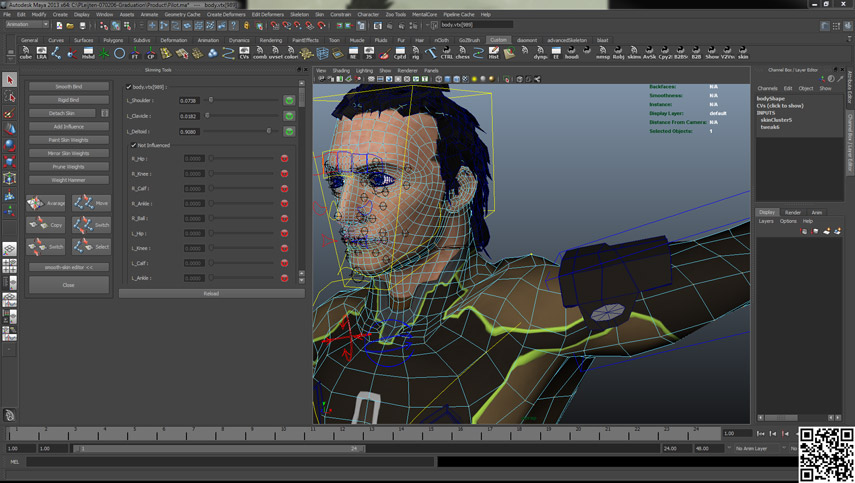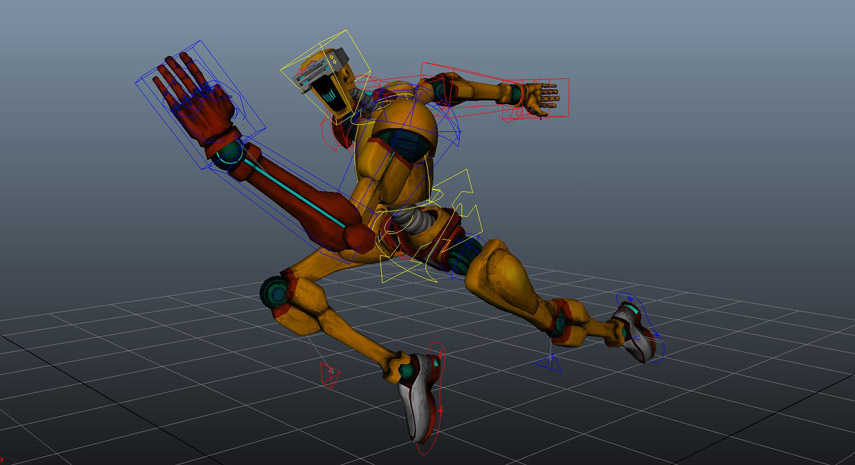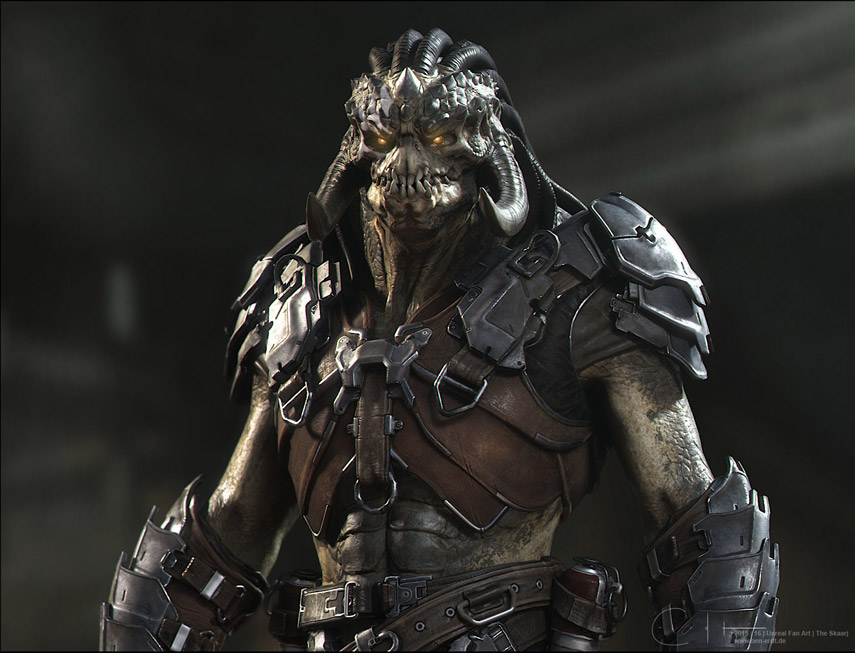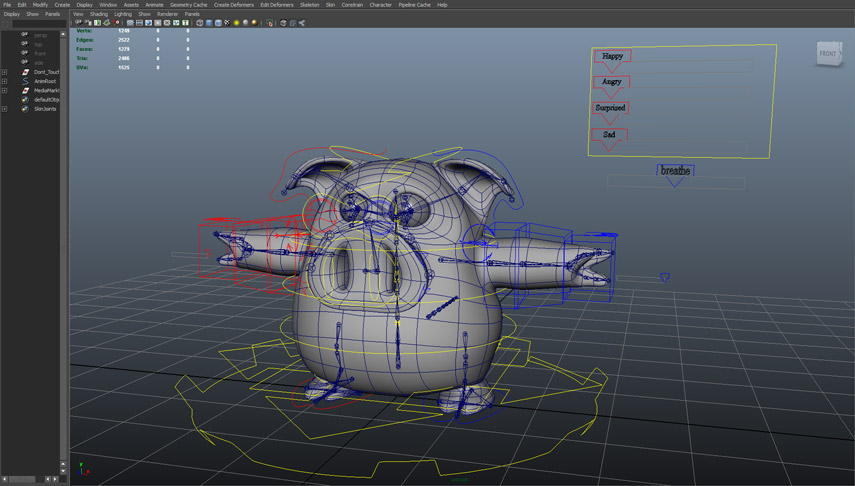Perry Leijten
 Perry Leijten is a highly skilled technical artist who has accumulated experience in multiple disciplines including rigging, skinning, and modeling (mechanical, organic and environmental), plus sculpting and texturing. With a widely-garnered specialization in rigging, Mel-scripting and python within Maya and Houdini, Leijten has become known for getting the job done faster but with an equal or higher level of quality. He enjoys working in a fast pace environment, adapts quickly to new environments and possesses an acute dedication that makes him an invaluable asset for every team. Leijten started out as a university teacher in Holland giving lectures in the basics of Maya modeling, rigging and python scripting, until he got a job offer from Guerrilla Games to work on Killzone: Shadow Fall and Horizon: Zero Dawn. He is currently working at Square Enix ATD as a Senior Rigging Technical Artist. In his spare time, he helps indie studios including RageSquid (Action Henk) and Twirlbound (Pine). To learn more, visit Perry Leijten’s website and Gnomon tutorial.
Perry Leijten is a highly skilled technical artist who has accumulated experience in multiple disciplines including rigging, skinning, and modeling (mechanical, organic and environmental), plus sculpting and texturing. With a widely-garnered specialization in rigging, Mel-scripting and python within Maya and Houdini, Leijten has become known for getting the job done faster but with an equal or higher level of quality. He enjoys working in a fast pace environment, adapts quickly to new environments and possesses an acute dedication that makes him an invaluable asset for every team. Leijten started out as a university teacher in Holland giving lectures in the basics of Maya modeling, rigging and python scripting, until he got a job offer from Guerrilla Games to work on Killzone: Shadow Fall and Horizon: Zero Dawn. He is currently working at Square Enix ATD as a Senior Rigging Technical Artist. In his spare time, he helps indie studios including RageSquid (Action Henk) and Twirlbound (Pine). To learn more, visit Perry Leijten’s website and Gnomon tutorial.
GW: What do the daily demands for a technical artist look like?
PL: This all depends on the studio. In the indie studios that I’ve worked for, it mainly consists of filling in the gaps of knowledge and expertise. For instance, both Twirlbound and RageSquid have strong animators, modelers and programmers, but no one to "quickly" rig the assets being created. So, in my spare time, I helped these studios out. As for bigger companies, it varies, as technical art can be split up into different sections. At Guerrilla Games it was a combination of scripting tools and rigging NPC's/ robots, next to the occasional firefighting (quickly fixing bugs/ helping out other teams with scripts to fix small annoyances). Now, at Square Enix, I am a part of an R&D team, which means I'm a lesser part of production. So, currently, I am doing research on new techniques and technologies that can improve a pipeline or help push the quality for upcoming games.
GW: You have an affinity for automating processes and writing scripts/tools to alleviate hiccups. Can you describe an example of this and how you came about the solution?
PL: Probably the tool I am most proud of is my skinning toolset. When I started out rigging, my least favorite part was skinning. Using a brush to paint influences for each vertex to assign which bone is allowed to move it on a character was a pain. In the beginning I also used a normal computer mouse which is impossible for this task as there is no pressure detection. Later on, when I got my first pen-tablet, it was a bit better but still had a lot of problems. In 2011, I started creating scripts that would just use selections as a base and a mathematical formula to apply values. Over the years this tool began to grow, adding more functionality and visual aides to remove the painting process, making it more a selection process. It’s available for free and it has seen over eight thousand downloads and it’s currently in use by multiple studios.

GW: Having an acute understanding of what each department in a production pipeline needs, plus being able to communicate effectively has been one of your key strengths. What helps you achieve that level of success?
PL: This, I must thank my education for. When I started my university in 2007, I had no clue about the game industry. I was starting out with a clean slate. I only touched Maya before for the intake exam. I was amazed by all the disciplines involved to create a videogame, and luckily, almost all those disciplines were taught at the school. But I also noticed each subject had some tedious aspects. For example: rigging has skinning, modelling has UV-ing, and so on. From the beginning I was always looking for tools and programs that might make the process more enjoyable or faster to create. It's not about just being comfortable in the main tool at hand, which for my education was Maya, but looking outside of your comfort zone and combining the powers of different tools and getting the job done quicker and more efficiently. Also knowing each part of the production pipeline by going through it yourself not only helps identify the bottlenecks in production, but also helps form an understanding of the people working with the tools and the processes they go through to complete their tasks.

GW: You’ve worked extensively in rigging and skinning for various projects. Can you describe the challenges you’ve encountered in each discipline?
PL: Both rigging and skinning create new challenges with each iteration and with each project. There is a base principle to adhere to, but depending on the platform it needs to be designed for, the parameters will inevitably change. Take Pine for example. The game has a cartoon-style-feel which also asks for cartoon-style-animation. The rigs need to be able to squash and stretch, but the main principles on how joints use their scaling information in Unity and Maya differs. Another challenge that I found interesting came about with the Robots in Horizon: Zero Dawn. For the foot-planting system, only humanoid type legs where allowed (2 bones) but the robots had animal hind legs (3 bones), so, I developed a system in which 2 bones could drive a 3 bone system. Later on the engine did support the 3 bone system, but the animators loved working with the rig that resulted out of the research. This rig is explained in the Gnomon Creature Rigging for Production tutorial.
GW: What were some of your favorite things about working on big games like Killzone: Shadow Fall and Horizon Zero Dawn?
PL: I started working on Killzone: Shadow Fall during final production, which means we were crunching away and putting everything in the game. This period can be stressful but can also be incredibly rewarding. We were working toward something really exciting and everything was coming together at such a fast pace. Therefore, it was very memorable.
I was able to work on Horizon: Zero Dawn before the final stages of production. I realized then that I loved that time before going into final production even more. This time period in the production pipeline is when some things are almost ready to be set in stone, but there is still some things left to figure out. For example, there is still time to talk with the modeler on changes you need for the character to have better deformations, but there is also time to talk with animators on how they want to control a character. It's the best time to try out some new ideas to put in a rig, and maybe push something original into the game. This back and forth between different disciplines became my favorite part of the development cycle.
GW: You’ve studied mechanical engineering which helped you create a real working model from that knowledge. For students who are looking to become a technical artist, can you name topics like this that would be a bonus to peruse?
PL: Mechanical engineering was something I researched during my last year in college. I did an internship at Guerrilla Games, and at the time, I knew that Horizon was in development. During my research, I found out that using actual mechanics in rigs was not common. What I created wasn't the most realistic model in terms of sizes, but the methods learned from it created a really good understanding of mechanics in motion. Rigging is all about motion, so one of the most common topics to study is anatomy; on how the muscles and skin move. This principle is applied to humans, animals, and other creatures to make them behave believably in a rig. The anatomy of a robot or any mechanical object for that matter stems from mechanical engineering, so, to make a believable motion of a car suspension, you need to know how the mechanical part behind the suspension works. With this knowledge you have a better understanding if a project needs to have the perfect solution for this motion, or if you can "cheat" your way out and still have it look like a believable motion.

GW: Can you describe your experience as an instructor for The Gnomon Workshop, or a favorite moment you had while creating your tutorial, Creature Rigging for Production?
PL: When I started my education, I relied heavily on my friends for help when it came to working in Maya. Six months later, this became an equal exchange of knowledge. Ever since then I had the feeling that it would be great to share knowledge with as many people as possible and creating the tutorials for The Gnomon Workshop made this possible. Even though the course was meant to be advanced, I snuck in some extra bonus material for beginners so they could keep up as well. I'm happy that the creature I had to work with was a blend of animalistic features onto a humanoid body with added mechanical parts. This way, I could mash together different sets of knowledge that I gained over the years and actually add some of my own research, too.
GW: You created the Skaarj rig for Gnomon collaborator, Ben Erdt. How was that experience?
PL: The Skaarj was my second collaboration with Ben. We actually did another project before that which is still in the works, but as we were contacted by 3D World magazine, Ben decided to create a different character from scratch. Ben is a very keen modeler who pushes himself further with every project, but he is also very open about the process and he’s always willing to incorporate interesting ideas that I have in terms of motion and possible rigging research. We have a pretty solid pipeline for those personal projects now. It starts when Ben has created concept art for a character, and we talk about all the stuff that might be interesting to add and to research during the process of creation. When the base sculpt is done, it will be passed to me for a first rig while Ben keeps on sculpting details. He has a very clear idea on how the character is supposed to work and even creates detailed documents on areas in the rig that don’t behave as he intended. We currently have a couple more characters planned and I hope to keep collaborating with him as I think it improves both our skills.

GW: Is there any other software or tools you like (not yet mentioned) that students and aspiring creators should consider?
PL: Knowing how to script in Python is something really important as more and more tools are implementing it as their base, especially extending that knowledge in Maya to PySide/PyQt can help create stunning looking tools and user interfaces that people would love to use. At the moment, for self-study, I am looking into a program called Krita which is open source and similar to Photoshop in combination with Illustrator. Best of all it has a python scripting interface which allows users to create their own tools for the package. For me, Python is a nice language that is easy to get into, so using it as the tool that allows users to modify your software could be a powerful addition.
GW: Is there a particular project in the past that changed your career for the better or a team moment from a past experience that still influences you your work ethic or pipeline approach today?
PL: Working on Horizon: Zero Dawn has significantly improved my career. Not only because the game has been so well received by players and critics alike but also because it was a project in which I could learn a lot from my peers and also bring my own input to the table. Even though I was almost fresh out of college, people would listen to my ideas good or bad and take them into consideration. New artists in the industry have a lot of fresh ideas and it is up to the industry veterans to apply their experience and see if such ideas are feasible. Some things might seem possible, but they also include a certain overhead that a young artist does not think about because they haven’t experienced it all yet. Having these subjects open for discussion with the explanation included to why something would or would not work allowed me to inherit some of the expert experience from my colleagues.

GW: Do you foresee any interesting technology breakthroughs or changes impacting CG in the future?
PL: There was one thing a few years ago that really grabbed my attention: Fabric Engine. But unfortunately, that got discontinued. For the people that don't know, Fabric Engine was a software that relied on other programs, sort of like a symbiosis, it could be integrated in Maya, 3ds max, Unreal, etc. From a technical artist point of view this would allow rigs to be created in Fabric and they would work the same in 3ds Max as they would work in Maya, so animators could work in the software they are most accustomed to. It was intuitive to work in as it was node based and the nodes where easily expanded upon with a scripting language called KL, which was not that difficult to learn. It’s a shame the software got discontinued and hopefully something similar will take its place.
GW: Thank you, Perry Leijten, for giving us such an honest and thorough break down of your experiences and processes. Your encouraging energy is contagious and very much appreciated! Cheers!
| Check out Creature Rigging for Production with Perry Leijten |






